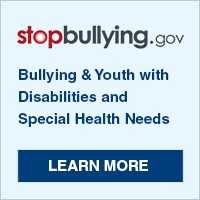Bullying

Bullying doesn’t just happen to the smallest kid in the class. Children who bully others target those who seem to be less powerful or not as strong. Children who bully others also often target children who seem “different”. Children with Tourette Syndrome (TS) and other disabilities are, therefore, at significantly higher risk of being bullied. It is important to understand the effects of bullying, a child’s legal right not to be bullied, and where to find additional resources.
Bullying, teasing, and harassment should not be considered normal rites of passage or just “kids being kids”.
Learn more about the effects of bullying, what adults can do to prevent bullying, and where to find additional resources.
What is bullying?
Bullying is unwanted, aggressive behavior that involves a real or perceived imbalance of power. The aggressive behavior is repeated, or has the potential to be repeated, over time.
- Bullying can be physical, involving hitting or attacking another person or their possessions.
- Bullying also can come in the form of verbal aggression, including teasing, name calling, verbal threats, inappropriate sexual comments, taunting, and threatening to cause harm.
- Bullying can also come in the form of social aggression, which involves hurting someone’s reputation or relationships. Social bullying can include leaving someone out on purpose, telling other children not to be friends with someone, spreading rumors about someone, or embarrassing someone in public.
Bullying can be in person, but it can also come in the form of electronic aggression (e.g.,, cyberbullying using the Internet or cell phones). It can include threatening, embarrassing, or insulting emails, texts, or social media posts.
What are the effects of bullying?
Children and youth who are bullied are more likely than other children to:
- Be depressed, lonely, anxious;
- Have low self-esteem;
- Experience headaches, stomachaches, tiredness, and poor eating;
- Be absent from school, dislike school, and have poorer school performance; and
- Think about suicide or plan for suicide.
Bullying can cause serious, lasting problems not only for children who are bullied but also for children who bully and those who witness bullying. Read more here.
Video

Watch a new video ‘Stand Up for Tourette Syndrome’ about how to handle teasing and bullying.
Legal Rights
There are laws to protect children by peers, school personnel, or other adults. TS is recognized as a disability in the Individuals with Disabilities Education Act (IDEA). Disability harassment is discrimination that violates section 504 and its regulations. Under Section 504 and Title II of the Americans with Disabilities Act, disability harassment in schools is defined as, “intimidation or abusive behavior toward a student based on disability that creates a hostile environment by interfering with or denying a student’s participation in or receipt of benefits, services, or opportunities in the institution’s program. Harassing conduct may take many forms, including verbal acts and name-calling, as well as nonverbal behavior, such as graphic and written statements, or conduct that is physically threatening, harmful, or humiliating.”
Find more information about federal laws related to bullying on StopBullying.gov.
Find more information about disability harassment from the U.S. Department of Education.
For More Information
- These sites have information from the Centers for Disease Control and Prevention.
- StopBullying.gov has information from the Federal Partners in Bullying Prevention about bullying and tips to make it stop.
- These sites have information about bullying for schools, parents, kids, and teens.
- These sites have information from the Tourette Association of America about bullying and what parents, teachers, and administrators can do to help.
- This site has a free app for parents to help prevent bullying, created by the Substance Abuse and Mental Health Agency (SAMHSA)
- Page last reviewed: May 11, 2017
- Page last updated: May 11, 2017
- Content source:



 ShareCompartir
ShareCompartir
